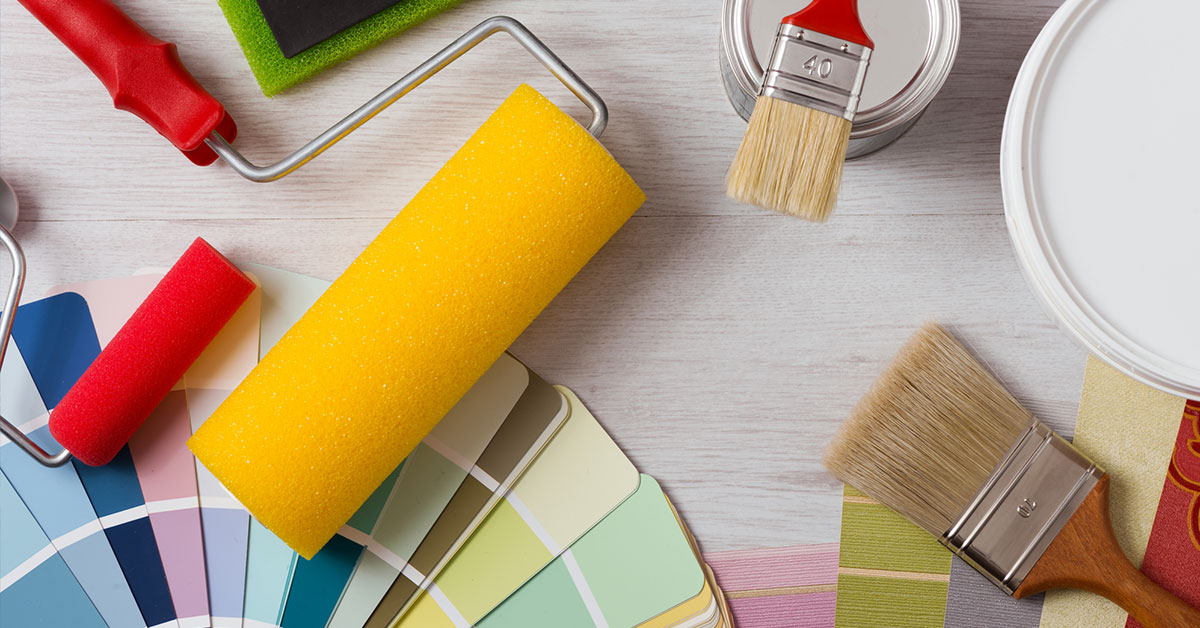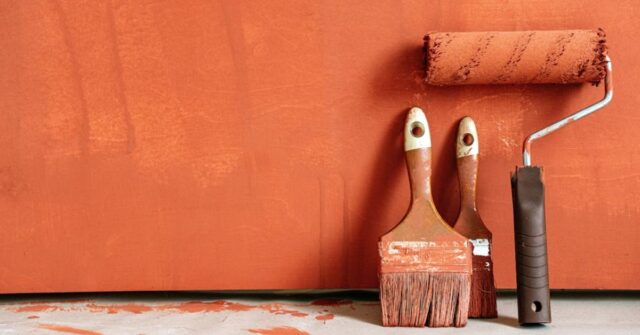In this article, we will explore painting and decorating tips that will help you achieve the best results in your home improvement projects.
From understanding the basics of painting and decorating to planning your project, preparing your space, and selecting the right accessories.
We will guide you through each step to ensure a successful and beautiful outcome.


Understanding the Basics of Painting and Decorating
Before starting any painting or decorating project, it’s essential to familiarize yourself with the tools, materials, and techniques involved.
This will help you make informed decisions and achieve a professional finish.
Types of Paints
There are various types of paints available on the market, such as water-based (latex or acrylic) and oil-based (alkyd) paints.
Each has its own set of advantages and drawbacks. Understanding the differences between these paint types will help you choose the best paint for your specific project needs.
Types of Brushes and Rollers
Different brushes and rollers are designed for specific purposes, such as cutting in, edging, or painting large surfaces.
Knowing the right brush or roller for each task will help you achieve a smooth and even paint application.
Decorating Tools and Materials
Various decorating tools and materials are available to help you achieve a unique and polished look, such as wallpaper, stencils, and decals.
Understanding how to use these tools effectively will enhance your space and make your project stand out.


Planning Your Painting and Decorating Project
Proper planning is crucial for a successful painting and decorating project.
From assessing your space to creating a budget and setting a timeline, careful planning will help you avoid common pitfalls and achieve your desired results.
Assessing Your Space
Before starting your project, take the time to assess your space, considering factors such as room size, natural light, and existing furniture.
This will help you make informed decisions about colour schemes, paint types, and decorative elements.
Choosing a Color Scheme
Selecting a colour scheme is a critical step in the planning process. Consider the mood and atmosphere you want to create, and choose colours that complement your existing decor and furniture.
Creating a Budget
Establishing a budget for your project will help you prioritize your needs and make cost-effective decisions about materials, tools, and accessories.
Setting a Timeline
Creating a realistic timeline for your project will help you stay on track and avoid last-minute scrambling.
Consider factors such as drying times, availability of materials, and your own schedule when setting your timeline.


Preparation for Painting and Decorating
Proper preparation is key to achieving a professional finish.
From cleaning and repairing surfaces to protecting your space and priming, taking the time to prepare your workspace will ensure a smoother painting and decorating process.
Cleaning and Repairing Surfaces
Before painting, clean and repair any cracks, holes, or imperfections on your surfaces. This will ensure a smooth and even paint application and help prevent future problems.
Protecting Your Space
Use drop cloths, painter’s tape, and other protective materials to safeguard your floors, furniture, and fixtures from paint splatters and accidents.
Priming the Surface
Applying primer before painting is essential for creating a smooth, even surface and ensuring proper paint adhesion.
It can also help improve paint coverage and durability, leading to a longer-lasting, more professional finish.


Painting Techniques for a Professional Finish
Utilizing proper painting techniques will help you achieve a professional, polished look.
From paint mixing and consistency to applying multiple coats and painting ceilings and trims, mastering these techniques will significantly improve your results.
Paint Mixing and Consistency
Thoroughly mix your paint to ensure even colour distribution and consistency. Stirring the paint before each use and maintaining a consistent paint thickness will result in a smooth, uniform finish.
Cutting In and Edging
Cutting in and edging are essential techniques for creating crisp, clean lines between walls, ceilings, and trims. Mastering these skills will give your project a professional touch.
Using a Paint Roller
When using a paint roller, apply even pressure and use a consistent rolling pattern to ensure a smooth, streak-free finish.
Make sure to load the roller with an adequate amount of paint and avoid pressing too hard or over-rolling, as this can create uneven textures.
Applying Multiple Coats
Applying multiple coats of paint will provide better coverage, durability, and colour depth.
Be sure to allow each coat to dry thoroughly before applying the next one, according to the manufacturer’s instructions.
Painting Ceilings and Trims
When painting ceilings and trims, use a smaller brush or roller for precision and control.
Make sure to use the appropriate type of paint for these surfaces, such as a semi-gloss or high-gloss finish for trims and a flat or matte finish for ceilings.


Decorating Ideas to Enhance Your Space
Once you’ve completed your painting project, consider adding decorative elements to further enhance and personalize your space.
From creating an accent wall to using stencils and decals, these decorating ideas will help bring your room to life.
Creating an Accent Wall
An accent wall can add visual interest and depth to your space. Choose a bold or contrasting colour, pattern, or texture to make your accent wall stand out.
Adding Texture with Wallpaper
Wallpaper can add texture, pattern, and colour to your walls, creating a unique and dynamic look. Consider using wallpaper on a single wall or in a small area for maximum impact.
Decorative Painting Techniques
Experiment with decorative painting techniques such as faux finishes, sponge painting, or colour washing to add depth and dimension to your walls.
Using Stencils and Decals
Stencils and decals are a simple and affordable way to add custom designs and patterns to your walls, furniture, and other surfaces. Choose designs that complement your existing decor for a cohesive look.
Choosing the Right Decorative Accessories
Selecting the right decorative accessories will help tie your space together and create a harmonious, polished look.
From artwork and lighting to window treatments and rugs, these finishing touches can make a significant impact on your overall design.
Selecting Artwork
Choose artwork that reflects your personal style and complements your colour scheme and decor. Consider the size, style, and placement of your art to create a balanced and visually appealing display.
Group smaller pieces together to create a gallery wall or use a large, statement piece to anchor your space.
Choosing Lighting
Lighting plays a crucial role in setting the mood and ambience of a room. Select a mix of ambient, task, and accent lighting to create a warm and inviting atmosphere.
Consider the style, size, and placement of your lighting fixtures to complement your decor and meet your functional needs.
Using Window Treatments
Window treatments can add colour, pattern, and texture to your space while providing privacy and light control. Choose curtains, blinds, or shades that complement your decor and match the style of your room.
Adding Rugs and Cushions
Rugs and cushions can provide comfort, colour, and pattern to your space. Choose pieces that complement your overall design and add visual interest to your room.
Styling Shelves and Tables
Accessorize your shelves and tables with a mix of decorative objects, books, and plants to create a balanced and visually interesting display.
Vary the height, size, and colour of your accessories to add depth and dimension to your space.


Maintaining Your Painted and Decorated Space
Proper maintenance is essential for preserving the beauty and longevity of your painted and decorated space.
From cleaning painted surfaces to repairing scratches and chips, regular upkeep will help keep your space looking fresh and inviting.
Cleaning Painted Surfaces
Keep your painted surfaces clean and free of dust and dirt by wiping them down with a damp cloth and mild detergent as needed.
Avoid using harsh chemicals or abrasive materials, as these can damage the paint.
Repairing Scratches and Chips
Address any scratches or chips in your paint promptly to prevent further damage. Lightly sand the affected area, apply a small amount of matching paint, and blend the edges for a seamless repair.
Refreshing Your Space
Periodically refresh your space by updating your decor and accessories or applying a fresh coat of paint. This will help keep your room feeling current and inviting.
Tips for a Sustainable and Eco-Friendly Painting and Decorating Project
Adopting sustainable and eco-friendly practices in your painting and decorating projects will help minimize your environmental impact and create a healthier living space.
From using low-VOC paints to recycling and disposing of paint properly, these tips will help you create a more sustainable project.
Using Low VOC Paints
Choose low-VOC (volatile organic compounds) paints to reduce harmful emissions and improve indoor air quality. These paints are better for your health and the environment.
Recycling and Disposing of Paint Properly
Dispose of leftover paint responsibly by donating it to a community organization, recycling it, or taking it to a hazardous waste disposal facility.
Never pour paint down the drain or throw it in the trash, as this can harm the environment.
Choosing Sustainable Decor Items
Select decor items made from sustainable materials, such as reclaimed wood, recycled metal, or natural fibres.
Support local artisans and companies that prioritize eco-friendly practices to reduce your environmental footprint.


Common Painting and Decorating Mistakes to Avoid
Avoiding common painting and decorating mistakes will help you achieve a professional finish and prevent unnecessary headaches.
From insufficient surface preparation to incorrect paint application and overlooking safety precautions, being aware of these potential pitfalls will help ensure a successful project.
Insufficient Surface Preparation
Skipping proper surface preparation can lead to uneven paint application, poor paint adhesion, and a less durable finish. Make sure to clean, repair, and prime your surfaces before painting to avoid these issues.
Incorrect Paint Application
Applying paint too thickly, using the wrong brush or roller, or not allowing enough drying time between coats can result in a subpar finish.
Follow best practices for paint application to achieve a smooth, even, and long-lasting result.
Overlooking Safety Precautions
Ignoring safety precautions, such as wearing protective gear, using proper ventilation, and securing ladders, can lead to accidents and injuries.
Always prioritize safety when undertaking a painting or decorating project.





